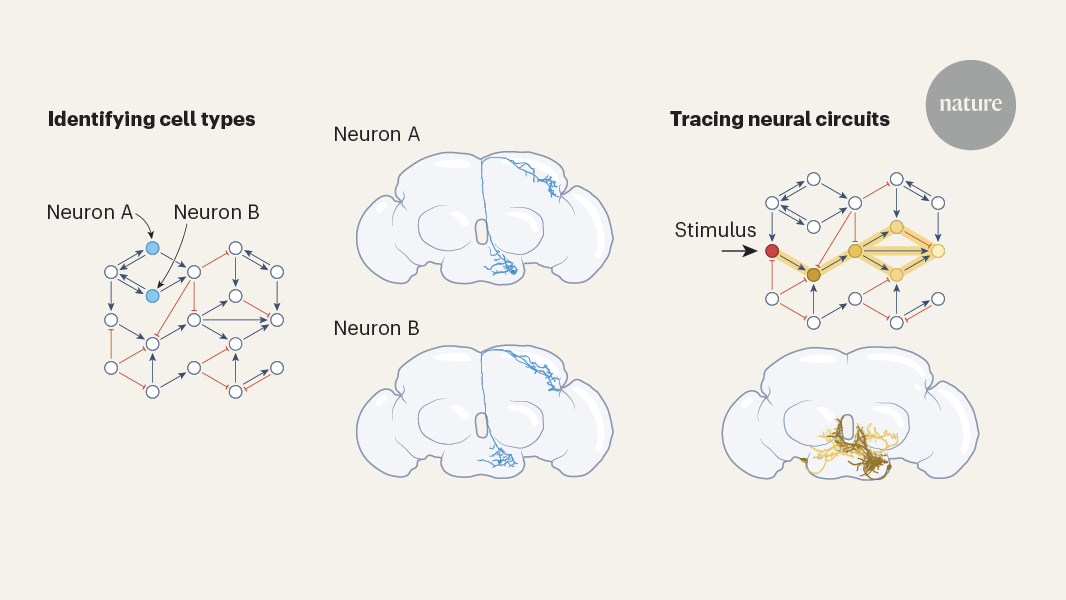Mapping the Complete Neural Wiring Diagram of the Fruit Fly Brain
核心概念
The first complete mapping of the neural connections in the adult fruit fly brain, a landmark achievement that will transform the understanding of brain function.
摘要
The article discusses the significance of mapping the complete connectome or wiring diagram of the brain, a task that is immensely complex for the human brain but more feasible for the smaller brain of the fruit fly, Drosophila melanogaster.
The key highlights are:
The human brain contains over 80 billion neurons and 100 trillion connections, making it an unfathomably complex task to map its complete connectome.
In contrast, the fruit fly brain contains one million times fewer neurons, yet flies can perform sophisticated behaviors like navigation, learning, decision-making, and social interactions.
Two studies, Dorkenwald et al. and Schlegel et al., have now described the first complete connectome of the adult Drosophila brain, a landmark achievement representing the largest connectome obtained so far.
Seven companion papers demonstrate the utility of this connectome in studying neural processing, providing a glimpse into how this resource will transform the field of neuroscience.
Mapping the complete neural wiring diagram of the fruit fly brain is a significant step towards understanding brain function and how it gives rise to complex behaviors.
A complete wiring diagram of the fruit-fly brain
統計資料
The human brain contains more than 80 billion neurons and 100 trillion connections.
The fruit fly brain contains one million times fewer neurons than the human brain.
引述
"Everything that we do, think or feel arises from the pattern of activity in our brains, which in turn is determined by how our brain cells are connected."
"The brain of the tiny fruit fly, Drosophila melanogaster, contains one million times fewer neurons than that of humans, yet flies can perform sophisticated behaviours such as navigation, learning, decision-making and social interactions."
從以下內容提煉的關鍵洞見
by Anita V. Dev... 於 www.nature.com 10-02-2024
https://www.nature.com/articles/d41586-024-03029-6
深入探究
How can the insights gained from the fruit fly connectome be applied to understanding the human brain and its complex functions?
The insights gained from the complete connectome of the fruit fly, Drosophila melanogaster, can significantly enhance our understanding of the human brain by providing a foundational model for studying neural connectivity and processing. Given that the fruit fly brain, despite its simplicity, exhibits sophisticated behaviors such as navigation, learning, and decision-making, researchers can use its connectome to identify fundamental principles of neural organization and function that may be conserved across species.
By analyzing the specific neural circuits and their connections in the fruit fly, scientists can draw parallels to similar circuits in the human brain, potentially uncovering how certain behaviors and cognitive functions are orchestrated at the neuronal level. Furthermore, the fruit fly's connectome serves as a valuable reference point for investigating the effects of genetic mutations and environmental factors on neural connectivity, which can be extrapolated to understand neurodevelopmental and neurodegenerative disorders in humans. This comparative approach can lead to the identification of conserved mechanisms underlying brain function, ultimately contributing to the development of targeted therapies for human neurological conditions.
What are the potential limitations or challenges in extrapolating findings from the fruit fly connectome to more complex brains?
While the fruit fly connectome provides a wealth of information, there are several limitations and challenges in extrapolating these findings to more complex brains, such as that of humans. One major challenge is the significant difference in the number of neurons and synaptic connections; the human brain contains over 80 billion neurons and approximately 100 trillion synapses, compared to the fruit fly's roughly 100,000 neurons. This vast complexity introduces a level of intricacy in human neural processing that may not be fully captured by the simpler fruit fly model.
Additionally, the functional roles of specific neurons and circuits can vary greatly between species. While certain neural pathways may be conserved, the context in which they operate can differ, leading to variations in behavior and cognitive function. Moreover, the fruit fly's relatively short lifespan and simpler behavioral repertoire limit the scope of its applicability to human brain functions, which are influenced by a lifetime of experiences and social interactions.
Finally, the methodologies used to map the fruit fly connectome may not be directly translatable to human brain studies due to ethical considerations and technical limitations in imaging and analyzing human neural networks. These factors necessitate a cautious approach when drawing conclusions from the fruit fly connectome to human brain function.
What other model organisms could be explored to further advance our understanding of brain connectivity and function?
In addition to the fruit fly, several other model organisms can be explored to advance our understanding of brain connectivity and function. One prominent candidate is the mouse (Mus musculus), which shares a significant amount of genetic and physiological similarity with humans. Mice are widely used in neuroscience research due to their well-characterized brain structure, the ability to manipulate genes, and the availability of advanced imaging techniques to study neural circuits in vivo.
Another valuable model organism is the zebrafish (Danio rerio), which offers unique advantages for studying brain development and function due to its transparent embryos and rapid development. Researchers can observe neural activity in real-time and investigate the effects of genetic modifications on brain connectivity and behavior.
Additionally, non-human primates, such as macaques, provide insights into more complex cognitive functions and social behaviors that are more analogous to humans. Their advanced brain structures and behavioral repertoires make them suitable for studying higher-order cognitive processes and the neural basis of social interactions.
Lastly, the roundworm Caenorhabditis elegans, with its fully mapped connectome and simple nervous system, serves as an excellent model for understanding basic principles of neural connectivity and function, particularly in the context of behavior and learning.
By leveraging these diverse model organisms, researchers can build a more comprehensive understanding of brain connectivity and function, ultimately contributing to the broader field of neuroscience.
0
